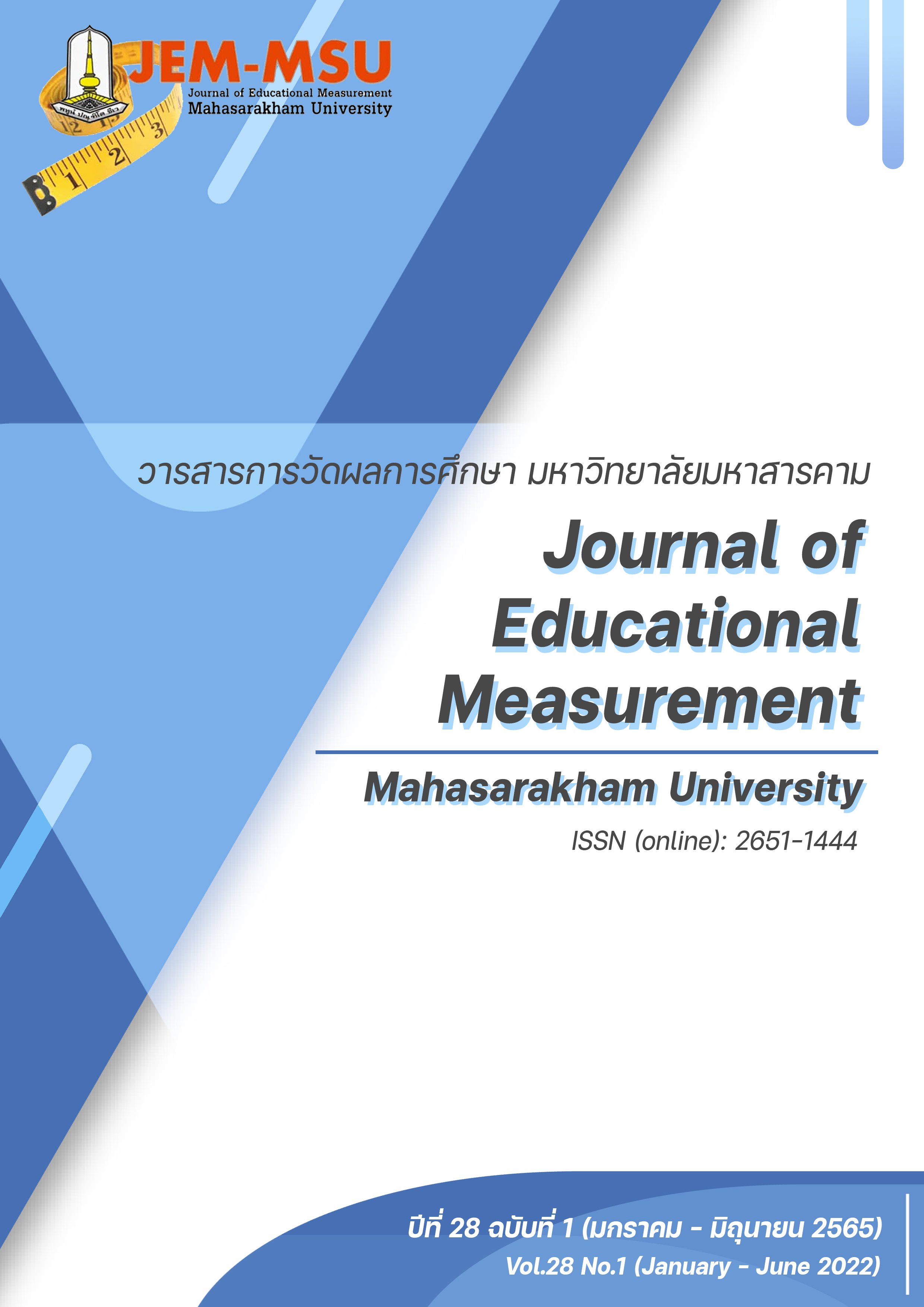Development of an Automatic Item Generation System for Item Bank Classified by Content and Difficulty Levels: Application of Assessment Engineering Concepts
Main Article Content
Abstract
The objectives of this research were 1) to create a mathematics item model in mathematics of grade 7, and 2) to develop an automatic item generation system for item bank classified by content and difficulty levels in mathematics of grade 7. The research was conducted in 2 phases. Phase 1 dealt with creating a mathematics item model in mathematics of grade 7. Phase 2 dealt with development of an automatic item generation system and to organize the item bank for grade 7, classified by content and difficulty levels in mathematics of grade 7.
The results showed that:
1. The mathematics item model in mathematics of grade 7 that was created consisted of 5 main parts: 1) stems, 2) elements, 3) options, 4) auxiliary Information and 5) keys. The items appropriate for creating an item model were 203 questions and were used to create 10 item model formats. On the whole, the item model was valid and passed the criteria.
2. The development of an automatic item generation system for item bank classified by content and difficulty levels in mathematics for grade 7 was carried out in the form of a web application which can be used via the Internet at https://www.aig-system.com. The overall program was suitable at a high level and accepted by the experts. The evaluation of the efficiency of the program was at a very good level, satisfying the program's users.
Article Details

This work is licensed under a Creative Commons Attribution-NonCommercial-NoDerivatives 4.0 International License.
The content and information contained in the published article in the Journal of Educational Measurement Mahasarakham University represent the opinions and responsibilities of the authors directly. The editorial board of the journal is not necessarily in agreement with or responsible for any of the content.
The articles, data, content, images, etc. that have been published in the Journal of Educational Measurement Mahasarakham University are copyrighted by the journal. If any individual or organization wishes to reproduce or perform any actions involving the entirety or any part of the content, they must obtain written permission from the Journal of Educational Measurement Mahasarakham University.
References
Arendasy, M. E., & Sommer, M. (2012). Using automatic item generation to meet the increasing item demands of high-stakes educational and occupational assessment. Learning and Individual Differences, 22(1), 112-117. doi:10.1016/j.lindif.2011.11.005
Gierl, M. J., & Lai, H. (2012). The Role of Item Models in Automatic Item Generation. International Journal of Testing, 12(3), 273-298. doi:10.1080/15305058.2011.635830
Gierl, M. J., & Lai, H. (2013). Instructional Topics in Educational Measurement (ITEMS) Module: Using Automated Processes to Generate Test Items. Educational Measurement: Issues and Practice, 32(3), 36-50.
Gierl, M. J., Lai, H., & Turner, S. R. (2012). Using automatic item generation to create multiple-choice test items. Med Educ, 46(8), 757-765. doi:10.1111/j.1365-2923.2012.04289.x
Gierl, M. J., Zhou, J., & Alves, C. (2008). Developing a Taxonomy of Item Model Types to Promote Assessment Engineering. The Journal of Technology, Learning, and Assessment, 7(2), 1-51.
Guyer, R., & Thompson, N.A. (2014). User’s Manual for Xcalibre item response theory calibration software, version 4.2.2 and later. Assessment Systems Corporation.
Luecht, R. M. (2013). Assessment Engineering Task Model Maps, Task Models and Templates as a New Way to Develop and Implement Test Specifications. Journal of Applied Testing Technology, 14, 1-38.
Polit, D. F., & Beck, C. T. (2006). The content validity index: are you sure you know what's being reported? Critique and recommendations. Res Nurs Health, 29(5), 489-497. doi:10.1002/nur.20147
Urry, V. W. (1977). Tailored Testing: A Successful Application of Latent Trait Theory. Journal of Education Measurement, 14(2), 181-196.
Chantharamaha, S. & Chadcham, S. (2018). Automatic Item Generation in Mathematics for Grade Six Students Using Computer Software. Research Methodology & Cognitive Science, 16(1), 138-149. (in Thai)
Jantana, S. (2019). Development of Automatic Item Generation in Mathematics Assessment for Grade Nine Level. [Master’s thesis]. Burapha University. (in Thai)
Pradujprom, P. & Panthong, K. (2019). A Computer Program for Developing Multiple Choice Test Items Using Automatic Item Generation Method. Journal of Southern Technology, 12(2), 74-87. (in Thai)
Preechapanich, O. (2014). Guide book: System Analysis and Design, Complete version. IDC Premier. (in Thai)
Tiansawad, S (2007). Content validity index: Critique and recommendation for computation. Nursing Journal, 34(4), 1-9. (in Thai)


